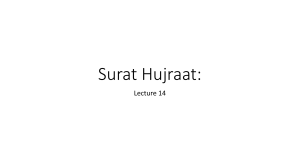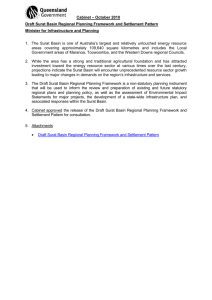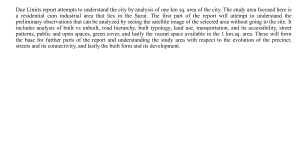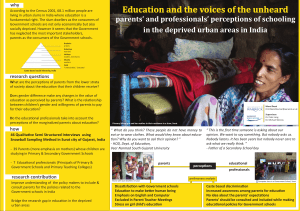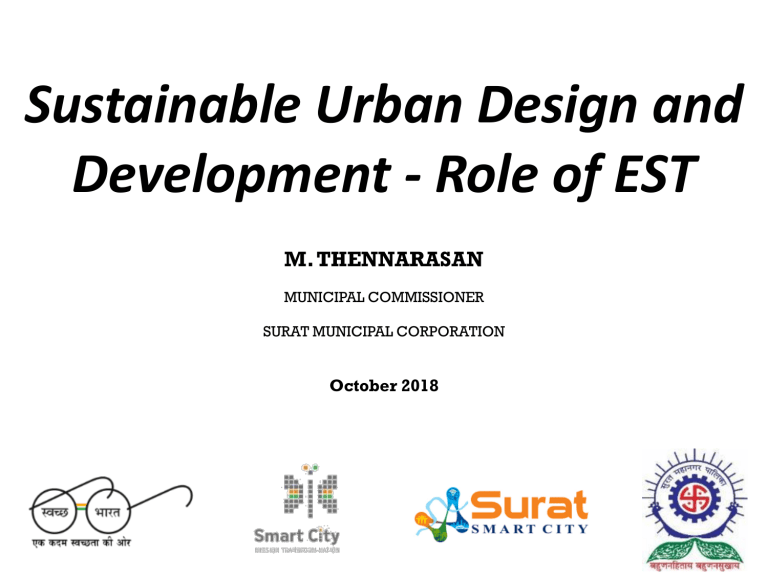
Sustainable Urban Design and Development - Role of EST M. THENNARASAN MUNICIPAL COMMISSIONER SURAT MUNICIPAL CORPORATION October 2018 8th Largest 4th fastest growing city in India as per population globally Termed as 9/10 Diamonds in the world are Economic Capital of cut and polished here Gujarat 40% of nations total man-made fabric & 28% of nation’s total man-made fiber production • Surat dates back to 300 BC • Density • Municipality Established in 1852 • Decadal Growth Rate : 60% to 80% (since 4 decades) • Municipal Corporation Formed in 1966 • Admin Zones :7 • Hazira Industrial Estate near the City • Ward Offices : 88 • An Environment with Peace, Alliance & Unity • Election Wards : 29 : ~138 Persons/ Ha (Census-2011) 8.18 2,88,026 1971 33.85 4,71,656 1981 55.56 7,76,583 1991 111.16 14,98,817 2001 112.27 24,33,785 2001* 326.51 28,77,241 2011 326.51 44,61,026 • Unprecedented growth in last four decades • Decadal Growth - 60-80% • In 2006 with the expansion of city limits, city area increased to three times 4,461,026 1961 2,433,785 2,23,182 1,498,817 8.18 776,583 1951 POPULATION GROWTH 471,656 Population 288,026 Area in Sq. Km 223,182 Year 1 9 5 11 9 6 11 9 7 11 9 8 11 9 9 12 0 0 12 0 1 1 SURAT CITY Administrative Boundaries: SMC comprises of : 326.52 Sq. km area 7 Zones 89 Wards Surat Urban Development Authority (SUDA) comprises of : 985.16 sq km area 121 Villages SURAT – URBAN TRANSPORT STATUS Population* – 5.92 Million (SMC) Employment* – 2.5 Million (SMC) Density – 376 pph (SMC) Vehicles Registered – 2.9 Million Major Road Network – 664 km (SMC) Major Road Network congested – 14% (72 km) Public Transport (PT) Network - 376 km Intermediate Public Transport Network • BRTS : 102 km |City bus: 274 km Average Travel Speeds • 2 wheeler 30 kmph • 3 wheeler 25 kmph • PT 20 kmph PT Network coverage - 87% (SMC) Accidents – 273 Fatal|327 Serious|190 Minor *2016 estimates • 38000 registered auto • 0.86 Million trips • 52 shared auto routes Air Quality • 1618 tons of emission every day (Transport sector) • 0.32 kg/day Per capita CO2 POPULATION PROJECTIONS CAGR 2011 50,81,856 - 2016 59,29,821 3.13% 2021 73,00,000 3.69% 2026 85,50,000 3.53% 2031 98,00,000 3.34% 2036 110,00,000 3.14% 2041 118,50,000 2.86% 2046 125,00,000 2.60% By 2036, Surat will be city • • • • 1 Crore people Year 2011 - Census Year 2016- Estimated population Year 2036- Projected population DP Year 2046- Projection Vehicle Registrations Millions Population Total Vehicles Year 4 3 2 1 0 Year 2W 3W Vehicles registered per day604 2W 481 4W 97 3W 3 Goods 5 Bus 1 4W total • Total Vehicles Registered in Surat till 2017 -2.9 Million • 1.67 Million Vehicles added in the last 10 Years. If this trend continues the total vehicles will grow by 2.9 times (2.9 Million to 8.4 Million) in 2046 FUTURE DEVELOPMENT/PROPOSALS - SUDA DP 2035 DFC Corridor Olpad Kathor Kamrej Ved Modal Multi Transport Hub Tena Rly station Adajan HSR Kadodara Hazira Pandesara Dream City Dream City Sachin GIDC AEROCITY (Towards Navsari) Palsana High Speed Rail Ahmedabad Mumbai Delhi Mumbai Freight Surat Railway Station Surat AeroCity Dream City Multi Modal Transport High Speed Rail Hub Corridor ProjectProject Metro EFFECTS OF FUTURE PROJECTS High Speed Rail DFC Improved Regional connectivity (intra / inter) Metro Dream city EFFECTS PROJECTS Ring Roads Rapid Growth in Economy Improved and Efficient trading activities Improved Standard of Living Aero city Faster , Safe and Seamless connectivity Logistic Park Multimodal Transit Hub FUTURE MOBILITY CHALLENGES IN SURAT Growth in the next 30 Years- Business as Usual Scenario 2046 2.1 times Growth in Population (5.92 Million to 12.5 Million) 2.9 times Growth in Personal Vehicle (2.9 Million to 8.4 Million) 2.3 times Increase in Passenger Journeys MOBILITY CHALLENGES IN SURAT 4 1.5 times Increase in Congestion (14% to 56%) times Reduction in Average Speed on the network (28kmph to 18kmph) 2.8 times Increase in Accident Probability 2 times Increase in GHG emissions 2.6 times Increase in Average Travel Time (13 mins to about 34 mins) VISION, STRATEGIC GOALS AND POLICY DIRECTIONS The vision SARAL in Indian languages means “Simple” which also implies mobility being Easy, Convenient and Accessible aimed towards a healthy living environment. The vision “SARAL Mobility 2046” is achieved through five strategic goals defined as: 1. Improving quality of life of people by providing for a Safe and Sustainable transport system 2. Supporting the economic growth in the city by enhancing Accessibility for people and goods to major activity centres. 3. Ensuring efficient connections by providing Reliable multi-modal travel options 4. Optimising transport system operations and enhancing travel experience of people through Advanced Technological Applications in transport. 5. Contributing to the environment by promoting Low carbon mobility COMPREHENSIVE MOBILITY PLAN 2046- PROPOSALS The plan bases, in line with NUTP, its proposals on two important lessons from cities around the world. No single mode is adequate to serve the mobility needs of the city, and Sustainability in cities can only be ensured, only if collective modes in general and buses in specific are provided with on-street priority. Proposals 1 Improving Street Network 2 Integrated Multi Modal Public Transport System 3 Transit Oriented Development 4 Pedestrians and Cyclists 5 Safety and Security 6 Adopting Smart Management Tools PROPOSAL 1:IMPROVING STREET NETWORK • Proposed to ensure connectivity, enhance accessibility and improve the efficiency. • The ring radial network proposed to resolve the issues identified above by completing the network, improving hierarchy and adding second and third level network. Road widths >=18m are proposed as “Transit Streets” with central bus stops and public transport given priority along the network. Sr. no. 2 Proposed Character Street Network (in Kms) New Network Improved Existing Network River Bridges (in numbers) 513 308 7 3 Rail Over cum Under Bridges (in numbers) 37 4 Transit Streets (>=18 m) (in Kms) 889 1 Values PROPOSAL 2: INTEGRATED MULTI MODAL PUBLIC TRANSPORT SYSTEM A 240Km network identified as strategic network, part of a higher order road network, connecting the main city to existing and upcoming regional centers. Develop a Multimodal Integrated public transportation to Surat system which provide seamless connectivity Alternative Analysis was done to identify the actual mass transit corridors The proposal also identifies 36 interchanges for seamless transfer through physical integration; the Surat Railway station, Majuragate and High-Speed Rail station are the major ones. PROPOSAL 2: INTEGRATED MULTI MODAL PUBLIC TRANSPORT SYSTEM A. City Bus and BRTS B. BRTS C. Surat Metro • Existing city bus network 274 km and additional 430 km by 2046 • All roads 18 m and above to be developed as transit streets. • Existing BRT 102 km another 100 km proposed as a part of the Plan. • The 201 Km of BRTS and 740 Km of City Bus network is expected to cater 24% of road network by rapid transit network and 76% by the city bus network. • This will increase the accessibility to transit by 23% thereby predicting a public transit ridership of 36 lakhs per day by 2046. D, High Mobility Corridor E. Feeder System F. Fare Integration A 12-km. high mobility corridor is also proposed and Operational along the inner ring road of Surat, with BRT/LRT as the preferred mode to cater to the high mobility demand of the core area of the city. • To ensure the last mile accessibility a feeder system adopting electric rickshaws or micro buses is proposed as part of the plan. • • An initial fleet of 40 rickshaws known as “Pink Autos”, which are operated by women are deployed as feeder system in the old city. An Integrated Fare system allows the transfer between multiple public transport modes with a single ticket thereby benefiting the users in terms of reduced travel time, distance, increased comfort while the operators benefit from better fleet utilization and increased ridership. A 73 Km of metro network is being proposed connecting the existing and proposed major economic centers. The alternative analysis identifies three potential corridors as metro corridors. a) Dream City to Kamrej (28.9 Km) b) Bhesan to Umbhel (26.3 Km) c) Majuragate to Karamala (15.8 Km) PROPOSAL 3:TRANSIT ORIENTED DEVELOPMENT TOD Optimize The Benefits Of Public Transport By Encouraging Higher Concentration Of Activities Around Transit Stations And Along Transit Corridors. • Plan focusses to improve walkability in transit area thereby encouraging the use of public transport • TOD corridor width of 200m long on either side of the public transport will bring about 140sq.km of area within 72 TOD zones. • A sensitive Local Area Plan (LAP) can incentivize the redevelopment within TOD • A properly designed Local Area Plan of TOD zones will make the 140 sq.km of area within 2.5 mins of walkable distance from the transit corridor. • TOD allows increased Value Capture from development along the transit corridors • FSI of 4 (1.8 base and 2.2 chargeable FSI) is provided in the Transit Zones of Surat • It is estimated that Rs 20,000 to 30,000 crores will be generated through TOD by 2046. PROPOSAL 4:PEDESTRIANS AND CYCLISTS • The plan proposes 488 Kms of footpaths above 1.8m and 288 Km of cycle network is identified with lane marking. • High priority has been assigned to accident-prone areas and streets with high pedestrian volumes. • The street network with adequate width but lacking walkability in the city must be renovated. • The plan proposes introduction of bicycle sharing systems with 1600 cycles, at old city having 40 bike docking points while the Sardar Vallabhbhai National Institute of Technology (SVNIT) has eight major docking stations. • Awareness campaigns and initiatives that help propagate the idea of walking and bicycling in the city is to be taken up. PROPOSAL 5:SAFETY AND SECURITY As part of the mobility management measures proposed, accident management is a key one. 1. Design improvement Signalisation: and Junction A total of 257 junctions have been identified (79 for improvement and 178 for signalisation). 2. Setting up of speed limits for the city: To reduce the road fatalities, it is proposed that National Highways have a speed limit of 65 kmph whereas in the case of urban city roads, all major roads should have a limit of 55 kmph, sub-arterial and collector roads 45 kmph. In the case of the old city, local streets and gamtal areas, the speeds are further reduced to 30 kmph. 3. Accident Monitoring Cell: The Traffic Police Department needs to institute a GIS based accident management cell which would look at analysing accidents, monitoring and devise strategies to reduce the same. Junction Improvement Phasing PROPOSAL 6:ADOPTING SMART MEASUREMENT TOOLS Pan city initiative requires continues monitoring across cities in all vehicles and throughout 16 operational hours. Thus, there is need for a system which maintain levels and increase reliability. 1. Intelligent Transit Management System (ITMS) ITMS is an urban transit project aimed at providing smooth, reliable, fast and affordable public transport with ease of travel and safety to the citizens of Surat along with real time monitoring of Buses, emergency vehicles and department vehicles. ITMS also provide faster incidence resolution and develop a rapid response for fire and emergency services. It also includes digitization of Depot and Incidence management procedures for quick actions. 2. Automatic Fare Collection System (AFCS) AFCS is an urban transit project aimed to simplify fare policy and ability for smart and integrated pricing, decrease dwell time, and no hassle of queue for ticketing. It will also increase rider experience and ease of use for customers to promote customer self-service. It also includes QR based paper tickets, mobile app for ticketing and Surat Money card (Common Card Payment System (CCPS)). Real Time Information & PIS Turn Stile and Surat Money Card ROAD DESIGN GUIDELINE The roadways in a city are expected to facilitate convenient interaction between different land uses and people’s activity pattern that reflects life style and culture of the city. While providing for safe and delay-free movement for the long distance travellers in the city. By Considering above aspects SMC has prepared road development guideline for different roads in Surat city. Classification of Urban roads; 1. 2. 3. 4. 5. 6. Urban Expressway Primary Arterial Secondary Arterial Sub-Arterial Collector streets Local Streets MEASURES FOR IMPROVING CAPACITY OF URBAN ROADS • Prohibition of on-street parking • Provision of segregated right-of-way for slow moving vehicles such as rickshaw, tanga and animal drawn carts. • Imposing restriction on slow moving vehicles through busy arterials/sub-arterials during selected periods. • Provision of adequate facilities for pedestrians and cycles. • Banning certain conflict movements at major intersections, particularly during peak hours. MODEL ROAD & SMART ROAD Smart Road ▪ ▪ ▪ ▪ ▪ ▪ Segregated Cycle Track Street Furniture Parking Landscaping Signages Service Lane MODEL ROAD & SMART ROAD Model Road ▪ ▪ ▪ ▪ ▪ ▪ Street Furniture Parking Landscaping Signages Service Lane Integrated City Bus stops MODEL ROAD & SMART ROAD MODEL ROAD & SMART ROAD ▪ The ‘polluter pays’ principle is the commonly accepted practice that those who produce pollution should bear the costs of managing it to prevent damage to human health or the environment. ▪ SMC is first ULB in India to implement Environment Improvement Charges ▪ Cross subsidization of charges between Residential and Non- Residential units across city ▪ Telescopic rate for properties based on size of property Area (Square Meter) Environment Improvement Charge Residential Non-Residential 0 to 25 0 30 25.01 to 50 25 40 50.01 to 100 30 50 100.01 to 200 175 350 200.01 to 400 300 600 400.01 to 500 450 900 500.00 or more 625 1250 SUSTAINABLE URBAN TRANSPORT INDEX (SUTI) SUSTAINABLE URBAN TRANSPORT INDEX - SUTI • A comprehensive framework to measure and monitor urban transport performance WRT SDG • Defines the status of the city transport WRT Indicators • Comparison with other cities in the Asia – Pacific Region • Monitor Progress • An ongoing process – periodically to be carried out • Collects data for comparative purposes • Enables Identification of deficiencies • Set targets • Enables to identify good practices & lessons • To receive feedback on indicators, Max-Min limits, Data base, Strategies APPROACH FOR SUTI DATA COLLECTION • Extent to which transport plans cover public transport, intermodal facilities and infrastructure for active modes • Modal share of active and public transport in commuting • Convenient access to public transport in commuting • Public transport quality and reliability • Traffic fatalities per 1,00,000 inhabitants Indicator Indicator Indicator Indicator Indicator 1 2 3 4 5 • Affordabilit y – travel costs as share of income • Operational costs of the public transport system • Investment in public transportati on systems • Air quality (PM 10) • Greenhouse gas emissions from transport Indicator Indicator Indicator Indicator Indicator 6 7 8 9 10 INPUT OUTPUT With Paratransit Without Paratransit 1 Extent to which transport plans cover public transport, intermodal facilities and infrastructure for active modes 87.50 87.50 2 Modal share of active and public transport in commuting 52.77 23.71 3 Convenient access to public transport service 90.70 90.70 4 Public transport quality and reliability 91.85 91.85 5 Traffic fatalities per 100.000 inhabitants 86.90 86.90 6 Affordability – travel costs as part of income 93.42 93.42 7 Operational costs of the public transport system 21.42 21.42 8 Investment in public transportation systems 63.37 63.37 9 Air quality (pm10) 36.96 36.96 10 Greenhouse gas emissions from transport C1 RESULT SPIDER DIAGRAM 93.29 93.29 SUTI INDEX RESULT Geometric mean – 60.50 COMPARISON WITH OTHER CITIES 1. Extent to which transport plans cover… 10. Greenhouse 100.00 2. Modal share 90.00 gas emissions 80.00 of active and from transport 70.00 public… 60.00 50.00 3. Convenient 9. Air quality 40.00 access to public 30.00 (pm10) 20.00 transport… 10.00 0.00 8. Investment in 4. Public public transport transportation… quality and… 7. Operational costs of the public… 6. Affordability – travel costs as part of income Geometric mean 47.80 Kathmandu 10. Greenhouse gas emissions from transport 9. Air quality (pm10) 8. Investment in public transportation… 7. Operational costs of the public transport… Hanoi 5. Traffic fatalities per 100.000… 1. Extent to which transport plans cover… 100.00 90.00 80.00 70.00 60.00 50.00 40.00 30.00 20.00 10.00 0.00 6. Affordability – travel costs as part of income 2. Modal share of active and public transport in… 3. Convenient access to public transport service 4. Public transport quality and reliability 5. Traffic fatalities per 100.000… Geometric mean 32.19 1. Extent to which transport plans cover public… 10. Greenhouse gas 100.00 2. Modal share of 90.00 emissions from active and public 80.00 70.00 transport transport in… 60.00 50.00 3. Convenient 9. Air quality 40.00 access to public 30.00 (pm10) 20.00 transport service 10.00 0.00 8. Investment in 4. Public transport public quality and transportation… reliability 7. Operational costs of the public transport system 6. Affordability – travel costs as part of income 5. Traffic fatalities per 100.000 inhabitants Geometric mean: 52.51 Greater Jakarta 1. Extent to which transport plans cover public transport, intermodal facilities and… 100.00 2. Modal share of active and 10. Greenhouse gas 90.00 public transport in 80.00 emissions from transport commuting 70.00 60.00 50.00 40.00 30.00 20.00 10.00 0.00 9. Air quality (pm10) 3. Convenient access to public transport service 8. Investment in public transportation systems 4. Public transport quality and reliability 7. Operational costs of the public transport system Surat 5. Traffic fatalities per 100.000 inhabitants 6. Affordability – travel costs as part of income Geometric mean: 60.5 TOWARDS A SMART AND SUSTAINABLE TRANSPORT SOLUTION JOURNEY OF– PUBLIC SYSTEM ‘SITILINK’ Surat Bus TRANSPORT Rapid Transit System SURAT CITY A journey from limited public transport to a world class public transport system SURAT THAT DEPENDED ON IPT...BEFORE 2007 40,000 auto rickshaws operating as public transport! SURAT WITH LIMITED PUBLIC TRANSPORT…2007 Introduction of City Bus services in 2007 Challenge for Surat to create Sustainable High Quality Public Transport BUS RAPID TRANSIT SYSTEM (BRTS)..2014 Introduction of Surat Sitilink BRTS services in 2014 SITILINK – CITY BUS SERVICE..2016 Introduction of Surat Sitilink City Bus service in 2016 SITILINK – HIGH MOBILITY CORRIDOR..2018 Introduction of Surat Sitilink High Mobility Corridor (HMC) service in 2018 RIDERSHIP (JAN’17 TO AUG’18) Ridership Jan‘17 to Aug'18(in Lakhs) 70.0 61.1 60.0 50.4 43.3 36.5 37.8 40.0 47.0 44.9 41.0 24.5 23.5 24.2 25.1 23.8 26.9 24.9 22.6 19.5 19.3 17.8 16.5 14.0 24.5 25.3 26.7 27.0 28.9 March'18 April'18 May'18 June'18 July'18 31.8 23.2 Feb'18 26.8 22.4 Nov'17 25.6 21.5 Oct'17 24.0 25.6 July'17 27.6 23.7 June'17 16.8 March'17 24.7 16.2 Feb'17 22.2 14.6 10.0 May'17 6.0 17.3 22.8 2.7 20.0 4.6 20.8 9.8 30.0 11.8 32.0 29.3 45.3 51.6 49.5 49.5 50.2 26.5 42.1 Jan'17 BRT Passenger CBS Passenger Total Passenger Highest Combined ridership (2.17 lacs) on 27th July BRTS: 1.15 lacs and City bus : 1.02 lacs Aug'18 Jan'18 Dec'17 Sept'17 Aug'17 0.0 April'17 Passengers in lakhs 50.0 55.4 53.7 SYSTEM PERFORMANCE INDICATOR Sr.No Indicators BRTS City Bus Total 1 Total network length completed 102 Km 276.13 km (SUDA : 53.56 km) 371.92 km 2 Total no. of routes 9 (1 Express) 28 37 160 (156 stops+4cabins) 520 (507 stops+10 HMC stops+3 HMC cabins) 673 operational stops + 7 cabins + 3 terminal + 5 stops not constructed 6:00 AM to 9:00 PM 6:00 AM to 9:00 PM 3 routes (4:00 Am to 11:30 PM) 6:00 AM to 9:00 PM 3 CB routes (4:00 Am to 11:30 PM) 3 4 5 Total no. of stops / Cabins Operational timings: Peak hours : Morning: 8:00 AM–11:00 AM Evening : 5:00 PM – 8:00 PM Morning: 8:00 AM–11:00 AM Evening : 5:00 PM – 8:00 PM Morning: 8:00 AM–11:00 AM Evening : 5:00 PM – 8:00 PM 6 Number of depots: Capacity of Depots (Approx.) 4 Bhesthan : 75 buses Pal RTO : 60 buses Kosad BRT : 75 buses Puna Gam : 3 L.P. Savani : 80 buses Kosad : 120 buses Bhesthan Garden : 75 buses 7 7 Average revenue km / bus / day 234 201 218 8 No. of operators: 3 2 5 9 Total no. of On road buses: (Total Fleet 438) Weekday 156 Sunday 143 Weekday 249 Sunday 200 Weekday 405 (FU 92.5%) Sunday 343 (FU 78.3%) MOBILITY OF SURAT CITY 2007: Rainbow Bus Service Integrated Transport Service IPT in 2007 2014: BRTS Service 2016: City Bus Service Towards Sustainable Future
